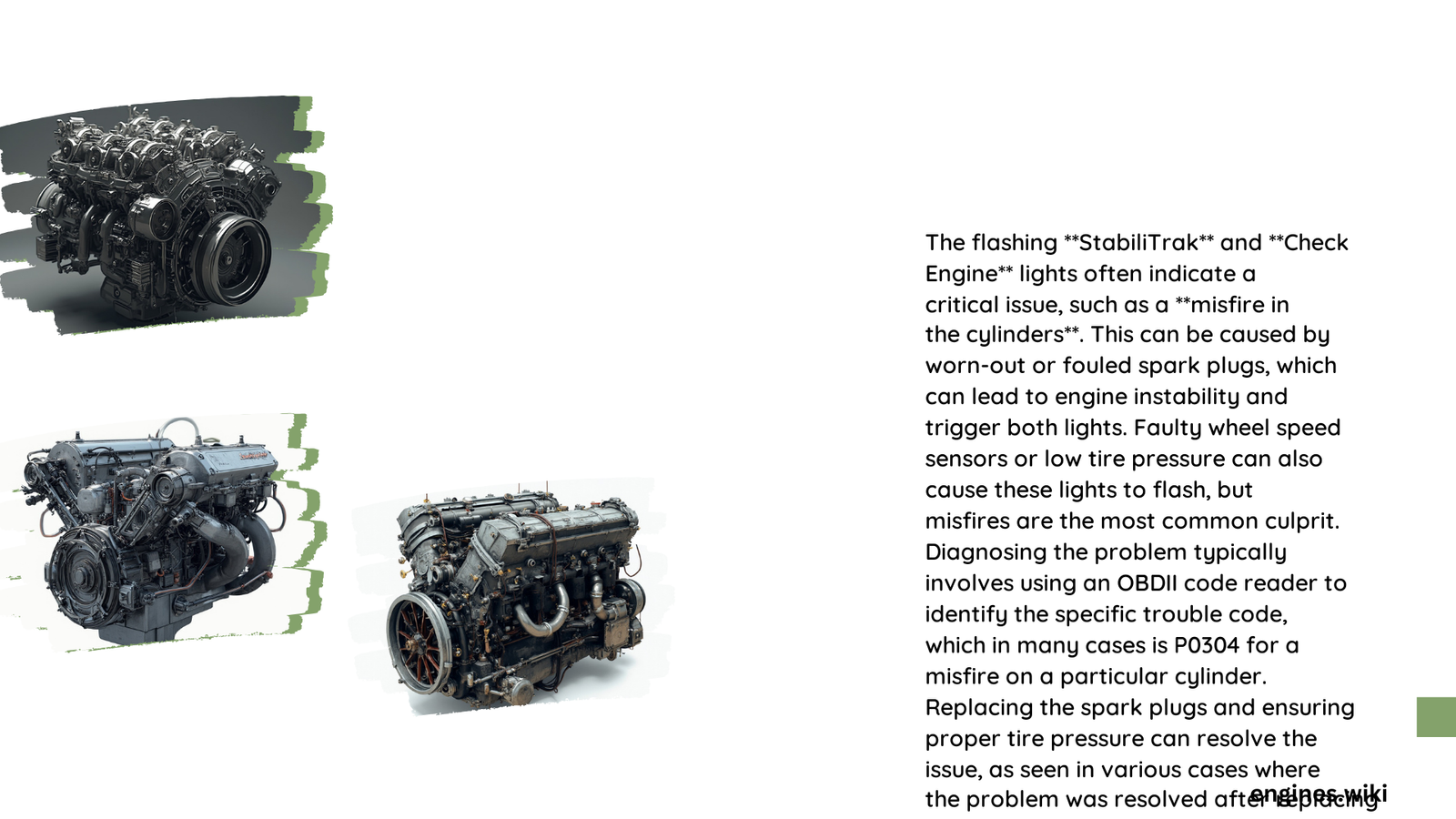When your vehicle’s stabilitrak system malfunctions and the check engine light starts flashing, it’s a clear indication of a serious issue that requires immediate attention. This combination often points to problems affecting engine performance, vehicle stability, and traction control. Common causes include misfires, faulty sensors, and issues with the traction control system. Prompt diagnosis and repair are crucial to ensure safe vehicle operation and prevent potential damage to your engine or transmission.
What Are the Common Causes of Stabilitrak and Check Engine Light Flashing?
Several issues can trigger both the stabilitrak warning and a flashing check engine light:
- Engine misfires
- Faulty oxygen (O2) sensors
- Malfunctioning Mass Airflow (MAF) sensor
- Wheel speed sensor problems
- Issues with camshaft or crankshaft position sensors
Let’s delve deeper into each of these causes and their potential solutions.
How Do Engine Misfires Affect Stabilitrak and Check Engine Light?

Engine misfires are one of the most common reasons for both the stabilitrak warning and a flashing check engine light. When an engine misfires, it creates instability that can affect the vehicle’s traction control system, triggering the stabilitrak warning.
Common causes of misfires include:
– Worn or faulty spark plugs
– Failing ignition coils
– Fuel injector issues
– Vacuum leaks
Diagnostic Trouble Codes (DTCs) related to misfires:
– P0300: Random/Multiple Cylinder Misfire Detected
– P0301-P0308: Cylinder 1-8 Misfire Detected
Repair solution: Replace faulty components (spark plugs, ignition coils, etc.)
– Cost: $100-$300
– Time frame: 1-3 hours
What Role Do Oxygen Sensors Play in This Issue?
Oxygen (O2) sensors play a crucial role in engine performance by monitoring exhaust gases and helping the engine computer adjust the fuel-air mixture. When an O2 sensor fails, it can lead to:
- Poor fuel economy
- Reduced engine performance
- Increased emissions
- Engine misfires
These issues can trigger both the check engine light and the stabilitrak warning.
Related DTCs:
– P0133-P0135: O2 Sensor Circuit Slow Response/Malfunction
Repair solution: Replace faulty O2 sensor
– Cost: $200-$500
– Time frame: 1-2 hours
How Does a Faulty MAF Sensor Contribute to the Problem?
The Mass Airflow (MAF) sensor measures the amount of air entering the engine. A malfunctioning MAF sensor can disrupt engine performance by causing:
- Incorrect fuel-air mixture
- Engine misfires
- Rough idling
- Poor acceleration
These issues can activate both the check engine light and the stabilitrak warning.
Related DTCs:
– P0101-P0103: Mass or Volume Air Flow Circuit Range/Performance/Low Input
Repair solution: Clean or replace the MAF sensor
– Cost: $100-$300
– Time frame: 1 hour
What Is the Connection Between Wheel Speed Sensors and These Warning Lights?
Wheel speed sensors are integral to the stabilitrak system, monitoring the speed of each wheel and sending data to the Electronic Stability Control (ESC) module. When a wheel speed sensor fails, it can cause:
- Inaccurate readings in the traction control system
- Activation of the stabilitrak warning light
- Potential triggering of the check engine light if engine performance is affected
Repair solution: Replace faulty wheel speed sensor
– Cost: $50-$200 per sensor
– Time frame: 1-2 hours
How Do Camshaft and Crankshaft Position Sensors Affect These Systems?
Camshaft and crankshaft position sensors help the engine computer determine when to fire the spark plugs. Issues with these sensors can lead to:
- Engine misfires
- Poor engine performance
- Difficulty starting the engine
These problems can trigger both the check engine light and the stabilitrak warning.
Related DTCs:
– P0335-P0338: Crankshaft Position Sensor Circuit Malfunction
– P0340-P0344: Camshaft Position Sensor Circuit Malfunction
Repair solution: Replace faulty sensor
– Cost: $100-$300 per sensor
– Time frame: 1-3 hours
What Steps Should I Take When Both Lights Are Activated?
When you experience both the stabilitrak warning and a flashing check engine light:
- Reduce speed and pull over safely as soon as possible.
- Turn off the engine and restart after a few minutes.
- If the problem persists, avoid driving the vehicle.
- Have the vehicle towed to a reputable mechanic or dealership.
- Use an OBD-II scanner to retrieve diagnostic trouble codes.
- Based on the codes, perform necessary repairs or replacements.
Can I Drive with Stabilitrak and Check Engine Light Flashing?
It is not recommended to drive your vehicle when both the stabilitrak warning and check engine light are flashing. This combination indicates a serious issue that could:
- Cause further damage to your engine or transmission
- Compromise your vehicle’s stability and safety
- Lead to a breakdown in potentially dangerous situations
Always prioritize safety and seek professional help when these warning lights are activated.
How Can I Prevent These Issues in the Future?
While some issues are unavoidable, you can reduce the risk of experiencing stabilitrak and check engine light problems by:
- Following your vehicle’s recommended maintenance schedule
- Regularly checking and replacing spark plugs and ignition coils
- Keeping your engine clean and well-maintained
- Addressing any performance issues promptly
- Using high-quality fuel and oil
- Avoiding aggressive driving, especially in poor road conditions
By staying proactive with your vehicle’s maintenance, you can minimize the chances of encountering these warning lights and ensure a safer, more reliable driving experience.
References:
1. Stabilitrak, flashing check engine, hair pulling
2. How to Fix Check Engine Light Flashing and Traction Control Light On
3. Easy Fix- GMC/Chevy 2007-2013 Flashing Check Engine/ Stabilitrak
